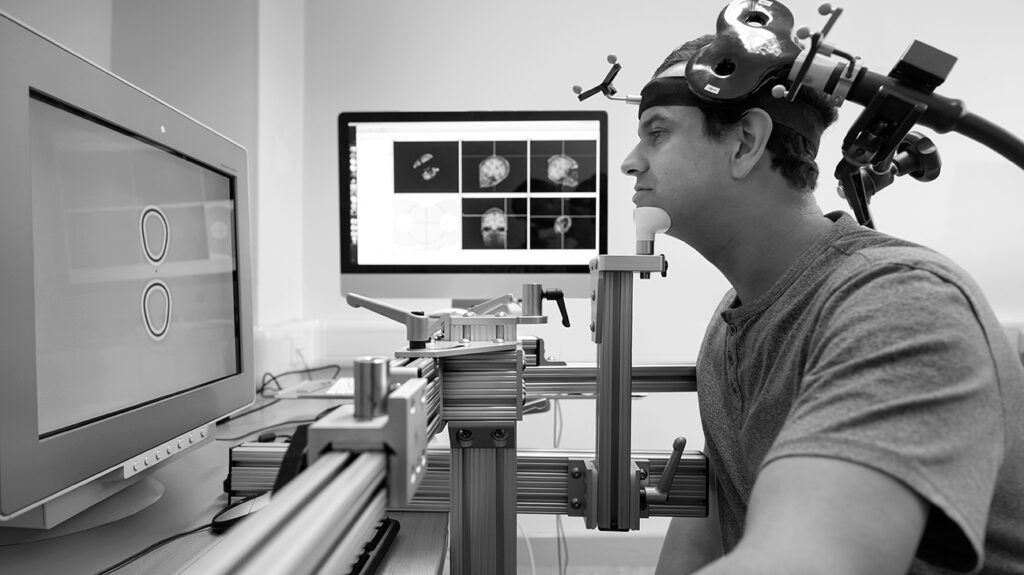Transcranial magnetic stimulation (TMS) is an effective alternative treatment for OCD. Here’s how this therapy can relieve symptoms.

Obsessive-compulsive disorder (OCD) is a mental health condition that’s characterized by unmanageable repetitive thoughts and compulsive behaviors. OCD symptoms can range from mild to severe and be distressful for those who live with them.
According to the
There are many treatment options currently available for people with OCD, including medication and therapy.
Research and experts suggest that an alternative treatment called transcranial magnetic stimulation (TMS) may also be able to help people treat or manage their OCD symptoms.
“Transcranial magnetic stimulation (TMS) is a noninvasive treatment that uses magnetic pulses (similar to those of an MRI machine) to awaken under-active parts of the brain in people who [live with] various mental health disorders,” says Ben Spielberg, neuroscientist and founder of TMS & Brain Health.
There are two types of TMS therapy:
- deep transcranial magnetic stimulation (dTMS)
- repetitive transcranial magnetic stimulation (rTMS)
Each therapy differs in intensity, session frequency, and benefits. The type of TMS you receive will depend on the symptoms you usually experience and any other needs you have based on your initial consultation with a TMS technician.
“Based upon decades of research, clinicians have found that this can be an effective and durable way to treat various conditions where regions of the brain are either underactive or overactive,” says Cory Anderson, Vice President of Clinical Affairs and Medical Operations at NeuroStar® Advanced Therapy.
As of 2018, the Food and Drug Administration (FDA) has approved TMS as an alternative treatment for OCD as well as the following mental health conditions:
- major depressive disorder (MDD)
- bipolar disorder depression
- smoking cessation
Spielberg notes that TMS has also shown potential and success for individuals who live with:
- anxiety
- insomnia
- post-traumatic stress disorder (PTSD)
- panic disorder
- adult attention deficit hyperactivity disorder (ADHD)
- chronic pain
- memory impairment
More research on TMS for OCD and mental health conditions is needed and underway.
“TMS has been investigated as a treatment for OCD for nearly 20 years, yielding promising results,” says Anderson. “Specifically, TMS has been shown to help patients control their obsessive thoughts and compulsive behaviors.”
To treat OCD specifically, Spielberg says that an area of the brain called the supplementary motor cortex (SMA) is targeted using a coil or helmet.
“An overactive SMA is often associated with internally triggered intrusive repetitive movements and thoughts,” he explains.
“Through targeting this area with an inhibitory (reduces maladaptive activity) protocol, patients are often able to find relief and break away from their obsessive patterns of thinking and behavior.”
When targeting the SMA for OCD symptoms does not do much to help, there are other possible locations in the brain that can be targeted during a TMS session.
These areas include:
- the orbitofrontal cortex (OFC)
- the dorsolateral prefrontal cortex (dlPFC)
- the anterior cingulate cortex (ACC)
A doctor will determine whether these protocols are right for the patient, adds Spielberg.
What does a TMS session for OCD look like?
Protocols can differ depending on each person’s experience living with OCD.
Typically, Spielberg says that “a TMS treatment course is kickstarted with an initial session where a technician performs one-time measurements to find the exact location of the SMA and often other areas of the brain that may be beneficial to treat.”
During a TMS for OCD session, the following might happen:
- You’ll undergo a primary consultation and mapping procedure.
- A technician will place a coil over the area(s) of the brain to be treated.
- Once in place, the treatment will begin. This might feel like a light tapping on your head.
- The technician might ask questions to check your progress or address any concerns.
A full treatment course usually includes sessions 5 days a week for 6 weeks. Each session can last around 15 to 30 minutes.
How long do the benefits last?
“Results vary between patients, and the clinical studies published for OCD so far [have] retained relatively short follow-up periods,” says Anderson.
But Spielberg notes that a full course of TMS will provide most people with symptom improvements for years to come.
“TMS has been shown to promote neuroplasticity (the formation of new connections in the brain), which can assist with developing new habits and patterns of thinking, potentially lasting a lifetime.”
Aside from this, Anderson points out that other benefits of TMS include:
- There’s no anesthesia, which means there’s no downtime from work or other activities.
- It’s a local treatment, meaning it has no systemic side effects.
Can TMS make OCD worse?
Spielberg says that TMS has not been shown to worsen OCD symptoms. “The FDA has cleared TMS to treat OCD, so they’ve determined it’s a safe and effective treatment when delivered according to the instructions for use,” says Anderson.
A TMS technician will also be checking in with the patient during every session to make sure they’re not experiencing any unwanted side effects, adds Spielberg.
Other conventional treatments for OCD are available.
According to a
But approximately half of people with OCD do not respond well to these methods.
A
This is why people with OCD are seeking alternative treatments that may help them, like repetitive TMS or deep TMS therapy.
Transcranial magnetic stimulation for OCD can be a safe, effective, and long lasting noninvasive treatment option.
Studies and experts suggest that folks with OCD and other mental health conditions, like major depressive disorder and bipolar disorder depression, can find relief with this FDA-approved treatment that could potentially last years.
If you’re wondering if TMS therapy for OCD can help you manage your symptoms, consider speaking with a mental health professional. A therapist or TMS specialist can help you determine which treatment is right for you.
To learn more about OCD, TMS, and other treatment options, you can check out the following resources:
